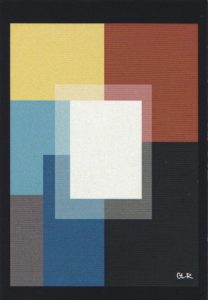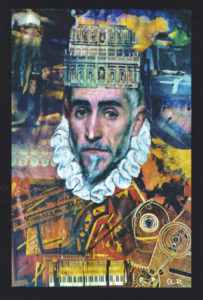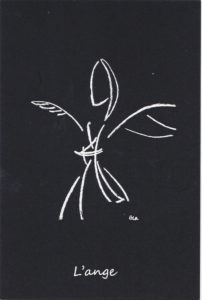Story Expansion
I provide additional services to enhance understanding of your life story and your
current outlook and perspective on life. These offerings are also helpful in preparation of a retirement plan. I provide each of the services below on a standalone basis or as part of a custom package. You can also start with any one of the following and later move to one of the basic or custom packages.
Imagery


Creating images to express human emotions and even a sense of the divine goes back thousands of years. Upper Paleolithic paintings found in Lascaux Cave in France are but one example. More recently, techniques for exploring the self and psyche using simple black and white images were developed at Harvard in the 1930s and 1940s.
Today it is widely understood that storytelling with images can elicit a wide range of insights useful for personal growth and development. Storytelling to images was even used to select and train Apollo astronauts who traveled to the moon! I offer five different approaches to the application of imagery, all with the goal of helping you further develop aspects of your life story.
One of my most-often used approaches to imagery work is utilizing a selection of card images designed by an artist in France, Dr. Nathalie Pilard. Dr. Pilard is also a religion, psychology, and Jungian scholar, and she has beautifully combined the breadth of her knowledge with creative imagery in cards designed for storytelling.


I have studied this innovative imagery method with Dr. Pilard and am currently the only certified source for her
techniques in the United States. One or more sessions utilizing the card imagery will help uncover and elaborate on
current life story preoccupations, hopes for the future, or other pressing questions and concerns.
Four additional imagery methods are available and we can customize an approach that
best serves your interests and needs.
“More than being simply a picture in the mind, an image is a complex representation of experience.” Jason Smith
Color
 The concept of using color to address disease and imbalances in the body has been found dating back to the ancient civilizations of India, Egypt, and China. Research today has shown the effects of color on the brain are real, for example the moderating influence of a specific shade of pink when feelings of anger or agitation arise. Colors, it has been noted, effect us on the physical, mental, and emotional levels.
The concept of using color to address disease and imbalances in the body has been found dating back to the ancient civilizations of India, Egypt, and China. Research today has shown the effects of color on the brain are real, for example the moderating influence of a specific shade of pink when feelings of anger or agitation arise. Colors, it has been noted, effect us on the physical, mental, and emotional levels.
Research since the 1940s has also shown how our selection of and reaction to certain colors is an indication of ongoing concerns, feelings, and issues in our lives. Clues to our motivations and emotions can be discerned via our preferences for energy patterns represented by specific color frequencies. Sometimes our feelings and motivating patterns lie just outside our day-to-day awareness. Or, we may have some inkling of their role in our life, but we prefer to avoid understanding or acting upon their significance.
Our color selections provide an objective degree of insight. Color preferences can help unlock these partially hidden or avoided patterns and desires. When these factor are better understood our life story can take on new meaning and direction.
My preferred approach is the use of the full-length, complete version of the Lüscher Color Test, a well-researched and respected assessment method used throughout the world. I have studied the Lüscher Color Test with Dr. Andreas Edelmann.
Our Personality Preferences
 The aspect of our being we commonly refer to as our ego-consciousness has certain preferred ways of operating and dealing with the world. Carl Jung, the Swiss psychiatrist, identified eight possible “psychological types,” and in our conscious approach to life we are each some combination of these. We all rely on a preferred and a secondary combination of “attitude” and “function,” while relying less on other personality type combinations which seem less natural and less developed.
The aspect of our being we commonly refer to as our ego-consciousness has certain preferred ways of operating and dealing with the world. Carl Jung, the Swiss psychiatrist, identified eight possible “psychological types,” and in our conscious approach to life we are each some combination of these. We all rely on a preferred and a secondary combination of “attitude” and “function,” while relying less on other personality type combinations which seem less natural and less developed.
Understanding our unique mix of personality type variables can provide a useful lens through which to view and understanding of our life story. As Jungian analyst John Beebe has noted, knowing our type helps in identifying what might be limiting us and what might assist in our growth and development.
As we move into midlife and beyond it is common to feel frustration, distress, and unease. As Murray Stein has said, “At midlife the psyche explodes…and reforms the landscapes of our psychological lives.” Knowing our past and present psychological preferences and how they may evolve as we age helps guide our life story and gives us renewed permission to be kind with ourselves as we experiment – and perhaps sometimes fail – with new ways of creating meaning.
Some people are familiar with the Myers-Briggs Type Indicator (MBTI), an assessment tool that aids in the application of Jung’s personality type preferences. Even those that have taken the MBTI are often unfamiliar with the full-length version and the depth of insight it offers. I prefer to use the recently revised Global Step II version of the MBTI, which offers greatly expanded insights into twenty personality preference and sub-preference areas. I am a certified Myers-Briggs Type Indicator consultant.

